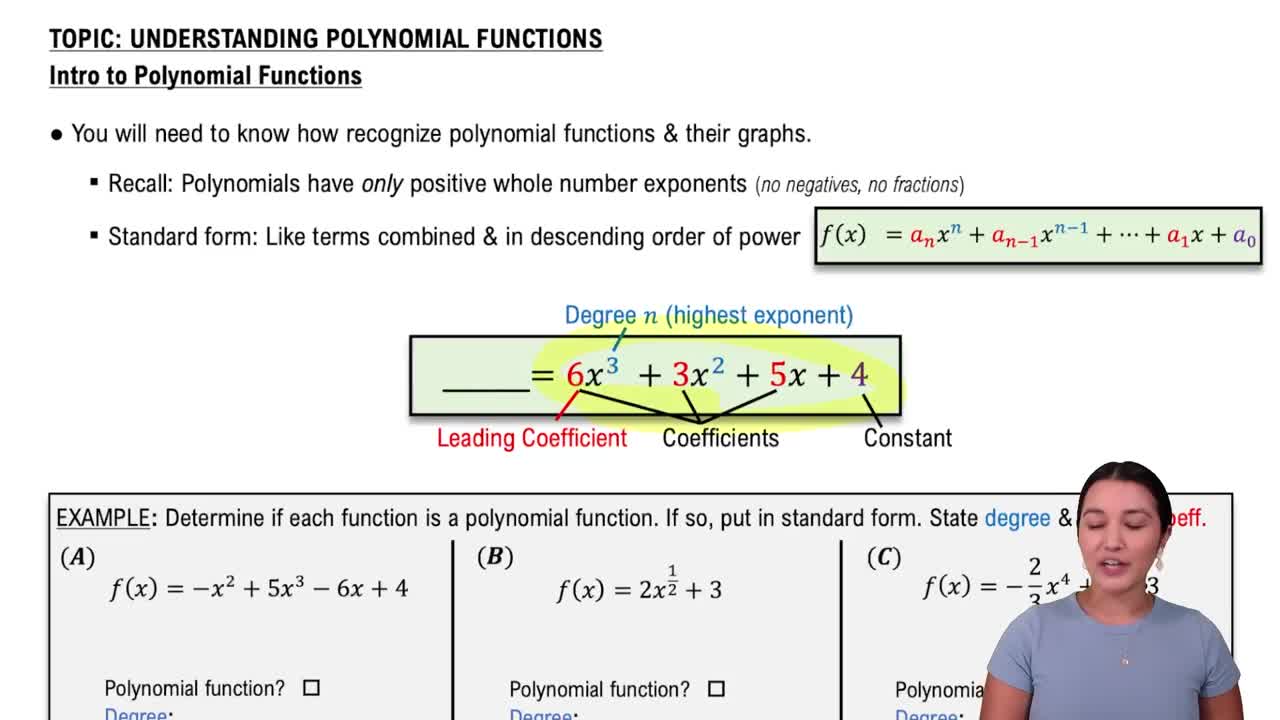Table of contents
- 0. Review of Algebra4h 16m
- 1. Equations & Inequalities3h 18m
- 2. Graphs of Equations43m
- 3. Functions2h 17m
- 4. Polynomial Functions1h 44m
- 5. Rational Functions1h 23m
- 6. Exponential & Logarithmic Functions2h 28m
- 7. Systems of Equations & Matrices4h 6m
- 8. Conic Sections2h 23m
- 9. Sequences, Series, & Induction1h 19m
- 10. Combinatorics & Probability1h 45m
4. Polynomial Functions
Zeros of Polynomial Functions
Problem 29
Textbook Question
In Exercises 25–32, find an nth-degree polynomial function with real coefficients satisfying the given conditions. If you are using a graphing utility, use it to graph the function and verify the real zeros and the given function value. n=4; i and 3i are zeros; f(-1) = 20
 Verified step by step guidance
Verified step by step guidance1
Identify the given zeros: Since the polynomial has real coefficients, the complex zeros must occur in conjugate pairs. Therefore, the zeros are \(i, -i, 3i,\) and \(-3i\).
Write the factors corresponding to the zeros: The factors are \((x - i), (x + i), (x - 3i),\) and \((x + 3i)\).
Multiply the factors to form the polynomial: Start by multiplying the conjugate pairs: \((x - i)(x + i) = x^2 + 1\) and \((x - 3i)(x + 3i) = x^2 + 9\).
Combine the results to form the polynomial: Multiply the results from the previous step: \((x^2 + 1)(x^2 + 9)\).
Determine the leading coefficient using the condition \(f(-1) = 20\): Substitute \(x = -1\) into the polynomial and set it equal to 20 to solve for the leading coefficient.
 Verified video answer for a similar problem:
Verified video answer for a similar problem:This video solution was recommended by our tutors as helpful for the problem above
Video duration:
5mPlay a video:
Was this helpful?
Key Concepts
Here are the essential concepts you must grasp in order to answer the question correctly.
Complex Conjugate Root Theorem
This theorem states that if a polynomial has real coefficients, then any non-real complex roots must occur in conjugate pairs. For example, if 'i' is a root, then '-i' must also be a root. In this case, since 'i' and '3i' are given as zeros, their conjugates '-i' and '-3i' must also be included as zeros of the polynomial.
Recommended video:

Complex Conjugates
Polynomial Function Construction
To construct a polynomial function from its roots, one can use the fact that if 'r' is a root, then '(x - r)' is a factor of the polynomial. For the given roots 'i', '-i', '3i', and '-3i', the polynomial can be expressed as the product of its factors: (x - i)(x + i)(x - 3i)(x + 3i), which simplifies to a polynomial of degree 4.
Recommended video:

Introduction to Polynomial Functions
Evaluating Polynomial Functions
Evaluating a polynomial function at a specific point involves substituting the value into the polynomial expression. In this case, we need to ensure that the polynomial satisfies the condition f(-1) = 20. This requires adjusting the polynomial's leading coefficient or constant term after constructing it to meet the specified function value at x = -1.
Recommended video:

Introduction to Polynomial Functions
Related Videos
Related Practice



